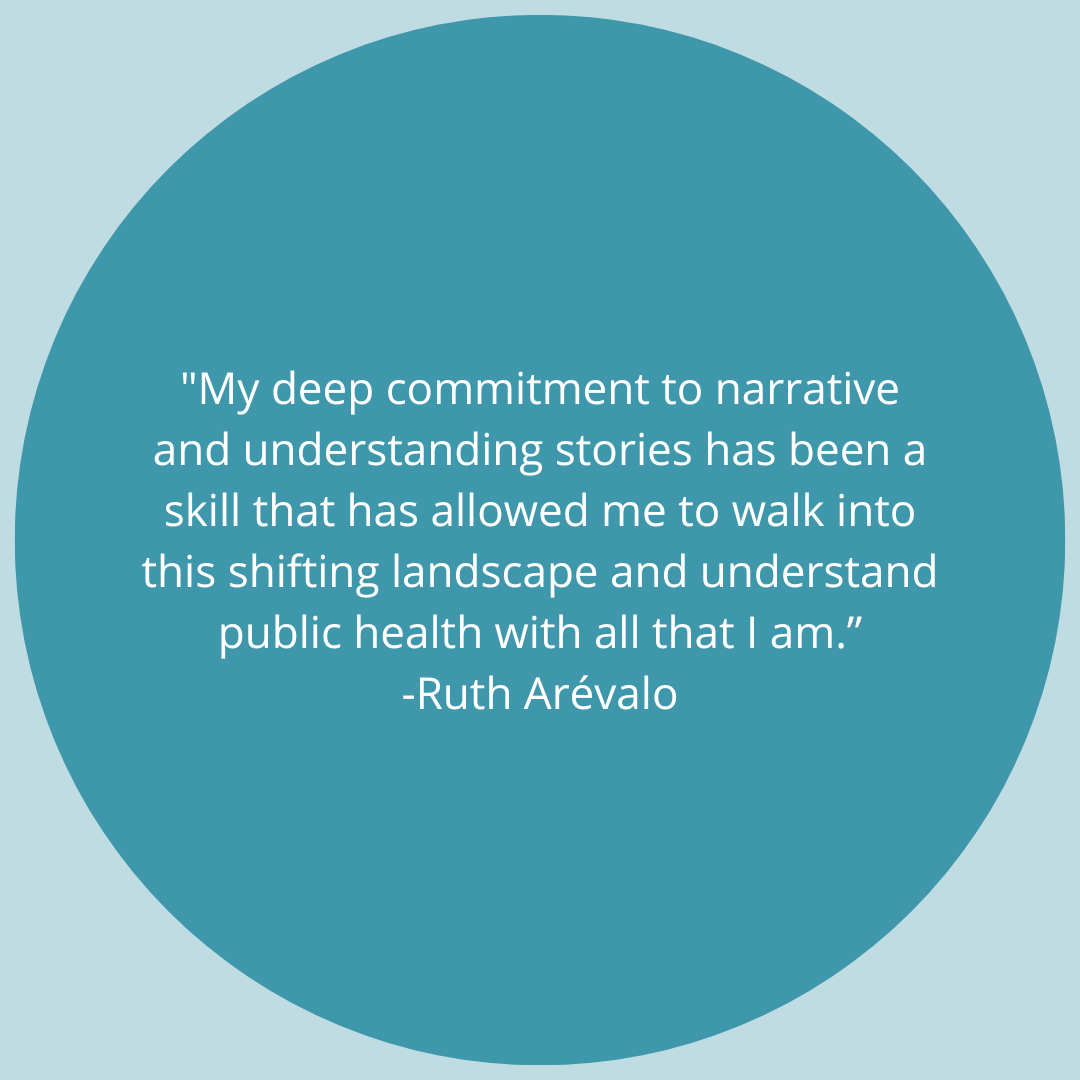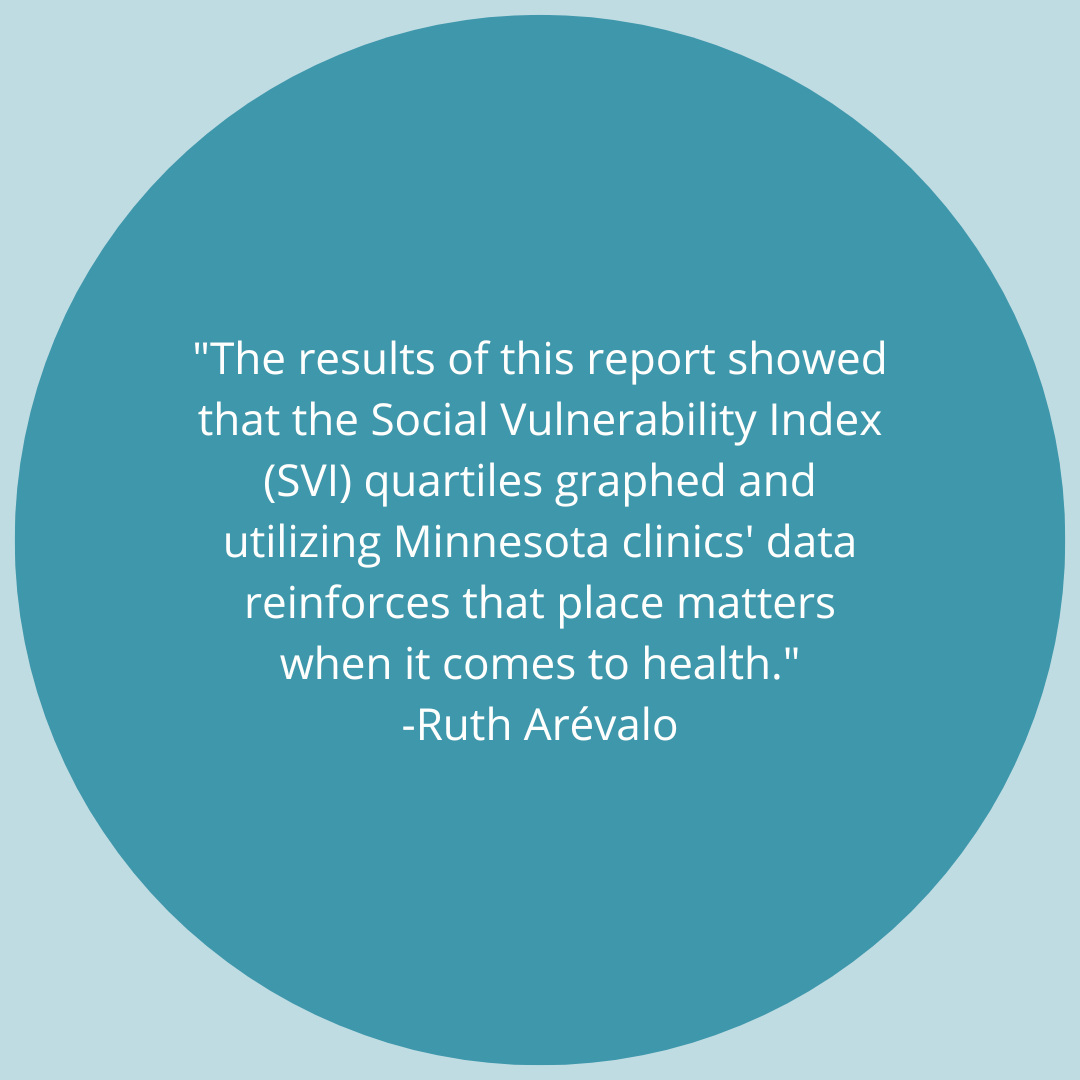#UMNMCH student Ruth Arévalo (MPH 2024) wrote this reflection on how community work, nursing career, and deployment have contributed to a career in Maternal and Child Health (MCH).

Understanding the Impacts of COVID-19 on Childhood Immunization Acquisition
In 2022 I began my deployment with Hennepin County Public Health (HCPH) as a Community Health Assessment and Project Intern. HCPH is a governmental organization that has a vision to help Hennepin County residents experience optimal health through the different programs that they offer. I completed my deployment with the Immulink and Baby Tracks programs within HCPH. Immulink is a program that partners with Minnesota Immunization Information Connection (MIIC) to track and ensure that Minnesota residents receive immunizations on a timely basis. Baby Tracks is a program in conjunction with Immulink that provides immunizations to children 0-2 to ensure on-time delivery of age-appropriate immunizations.
While working under the guidance of HCPH’s Marie Maslowski, I started my work trying to understand and extrapolate the ongoing conversation of how the COVID-19 Pandemic and vaccine fatigue have impacted the acquisition of childhood immunizations amongst a rise in recent cases (2022) in Minnesota of vaccine-preventable illness. The multifaceted issue brought many things to the conversation but one area that was of desired inquiry of HCPH was to understand how health care provider practice around childhood immunization education with parents-to-be/new parents could affect immunization acquisition. I conducted a condensed literature review of healthcare provider educational practices of childhood immunization, parent perceptions of childhood immunization education, and factors that affected the likelihood that a parent would acquire their child’s immunizations. After analysis and synthesis of the literature, I helped create and format a survey for Hennepin County providers and doulas. I also was able to compile lists of providers and doulas for potential survey participation. My efforts were left as a detailed outline and ready to go through the IRB process.
Social Vulnerability Index Comparison on Childhood Vaccine Acquisition

In conjunction with looking at childhood immunization practice, I also worked with Immulink regional coordinator, Cameron Bright, to author a report and final deliverable that utilized the Social Vulnerability Index (SVI). The data allowed me to share a story of how the SVI can shape how we see and understand childhood immunization acquisition in Minnesota. The SVI index utilizes 16 U.S. census variables to look at the social vulnerability of how external stresses can have potentially negative effects on human health and well-being. The social vulnerability index (SVI) is examined using four themes (socioeconomic status, household characteristics, racial/ethnic minority status, and housing type and transportation). Using the CDC’s Social Vulnerability Index (SVI), Hennepin County Public Health ranked the ZIP code areas of the state and divided them into quartiles. Quartile 1 (Q1) represents the areas of highest disadvantage and quartile 4 (Q4) has the lowest disadvantage. I then ran MICC reports through the Minnesota Department of Health (MDH) on childhood immunization acquisition rates from 6 SVI 1 and 7 SVI 4 clinics. The MIIC childhood assessment report measured the rate at which children aged 24-35 months were up to date on their vaccines (9 recommended vaccines) by 24 months, as defined by the Advisory Committee on Immunization Practices (ACIP). I pulled data from each of the clinics and graphed rates across immunization types and then across SVI quartiles. The results of this report showed the SVI quartiles graphed and utilized Minnesota clinics’ data that reinforces that place matters when it comes to health. Minnesota SVI 1 clinics had lower acquisition rates across the board.
How We Find “Story” in All That We Do. We Walk as We Question.
My time with HCPH has added to the non-linearity of my story of self. My deep commitment to narrative and understanding stories has been a skill that has allowed me to walk into this shifting landscape and understand public health with all that I am. Working with HCPH brought all new environments and relationships that I had never been in before. Because of my community engagement, nursing background, MCH coursework, and this deployment, I have been able to listen attentively and ask questions along the way to further the dynamic relationship of change within HCPH and the outlook of further public health issues. It remains imperative to be intentional about the stories we create and how we use questions, data, and information to tell stories of our complex world.
SOURCES/REFERENCES
About MIIC – Minnesota Dept. of Health. (n.d.). Www.health.state.mn.us.
https://www.health.state.mn.us/people/immunize/miic/about.html
ATSDR. (2020, October 15). CDC’s Social Vulnerability Index (SVI). Www.atsdr.cdc.gov.
https://www.atsdr.cdc.gov/placeandhealth/svi/index.html
Baby tracks. (n.d.). Hennepin County, Minnesota. https://www.hennepin.us/residents/health-medical/baby-tracks
CDC. (2023, February 10). Birth-18 years immunization schedule. Centers for Disease
Control and Prevention; CDC.
https://www.cdc.gov/vaccines/schedules/hcp/imz/child-adolescent.html
Health officials confirm two cases of measles in Hennepin County siblings – MN Dept. of Health. (n.d.). https://www.health.state.mn.us/news/pressrel/2022/measles061422.html
ImmuLink. (n.d.). Hennepin County, Minnesota. https://www.hennepin.us/residents/health-medical/immulink
Place matters: The environment we create shapes the foundations of healthy development – Center on the Developing Child at Harvard University. (2023, April 24). Center on the Developing Child at Harvard University. https://developingchild.harvard.edu/place-matters-the-environment-we-create-shapes-the-foundations-of-healthy-development/
Su, Z., Cheshmehzangi, A., Cheshmehzangi, A., McDonnell, D., Da Veiga, C. P., & Xiang, Y. (2022). Mind the “Vaccine fatigue.” Frontiers in Immunology, 13. https://doi.org/10.3389/fimmu.2022.839433
BIO
Ruthie is a third-year MCH MPH student. Ruthie received an AS from the California Culinary Academy and two BS degrees from the University of Utah.
Interested in learning more about getting a degree in MCH? Visit our MCH Program page for more information.
#UMNMCH #UMNproud #UMNdriven